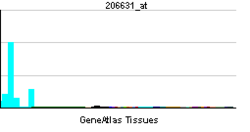Prostaglandin EP2 receptor
| View/Edit Human | View/Edit Mouse |
Prostaglandin E2 receptor 2 (53kDa), also known as EP2, is a prostaglandin receptor for prostaglandin E2 (PGE2). It is encoded by the human gene PTGER2.[4]
It may be associated with aspirin-induced asthma.[5]
Mechanism
The receptor is a G-protein coupled receptor, which activates the G protein Gs.[6]
See also
- Prostaglandin E2 receptor 1 (EP1)
- Prostaglandin E2 receptor 3 (EP3)
- Prostaglandin E2 receptor 4 (EP4)
- Eicosanoid receptor
References
- ↑ "Drugs that physically interact with Prostaglandin E2 receptor EP2 subtype view/edit references on wikidata".
- ↑ "Human PubMed Reference:".
- ↑ "Mouse PubMed Reference:".
- ↑ "Entrez Gene: PTGER2 prostaglandin E receptor 2 (subtype EP2), 53kDa".
- ↑ Jinnai N, Sakagami T, Sekigawa T, et al. (December 2004). "Polymorphisms in the prostaglandin E2 receptor subtype 2 gene confer susceptibility to aspirin-intolerant asthma: a candidate gene approach". Hum. Mol. Genet. 13 (24): 3203–17. doi:10.1093/hmg/ddh332. PMID 15496426.
- ↑ Invitrogen Online Ordering: Prostanoid Receptor PTGER2 Assays
External links
- "Prostanoid Receptor: EP2". IUPHAR Database of Receptors and Ion Channels. International Union of Basic and Clinical Pharmacology.
Further reading
- Duncan AM, Anderson LL, Funk CD, et al. (1995). "Chromosomal localization of the human prostanoid receptor gene family.". Genomics. 25 (3): 740–2. doi:10.1016/0888-7543(95)80022-E. PMID 7759114.
- Wu H, Wu T, Hua W, Dong X, et al. (2015). "PGE2 receptor agonist misoprostol protects brain against intracerebral hemorrhage in mice.". Neurobiol Aging. 36 (3): 1439–50. doi:10.1016/j.neurobiolaging.2014.12.029. PMID 25623334.
- Regan JW, Bailey TJ, Pepperl DJ, et al. (1994). "Cloning of a novel human prostaglandin receptor with characteristics of the pharmacologically defined EP2 subtype.". Mol. Pharmacol. 46 (2): 213–20. PMID 8078484.
- Wu H, Wu T, Han X, Wan J, et al. (2016). "Cerebroprotection by the neuronal PGE2 receptor EP2 after intracerebral hemorrhage in middle-aged mice.". J Cereb Blood Flow Metab. doi:10.1177/0271678X15625351. PMID 26746866.
- Bastien L, Sawyer N, Grygorczyk R, et al. (1994). "Cloning, functional expression, and characterization of the human prostaglandin E2 receptor EP2 subtype.". J. Biol. Chem. 269 (16): 11873–7. PMID 8163486.
- An S, Yang J, Xia M, Goetzl EJ (1994). "Cloning and expression of the EP2 subtype of human receptors for prostaglandin E2.". Biochem. Biophys. Res. Commun. 197 (1): 263–70. doi:10.1006/bbrc.1993.2470. PMID 8250933.
- Stillman BA, Breyer MD, Breyer RM (1999). "Importance of the extracellular domain for prostaglandin EP(2) receptor function.". Mol. Pharmacol. 56 (3): 545–51. PMID 10462542.
- Smock SL, Pan LC, Castleberry TA, et al. (1999). "Cloning, structural characterization, and chromosomal localization of the gene encoding the human prostaglandin E(2) receptor EP2 subtype.". Gene. 237 (2): 393–402. doi:10.1016/S0378-1119(99)00323-6. PMID 10521663.
- Desai S, April H, Nwaneshiudu C, Ashby B (2001). "Comparison of agonist-induced internalization of the human EP2 and EP4 prostaglandin receptors: role of the carboxyl terminus in EP4 receptor sequestration.". Mol. Pharmacol. 58 (6): 1279–86. PMID 11093764.
- Duckworth N, Marshall K, Clayton JK (2002). "An investigation of the effect of the prostaglandin EP2 receptor agonist, butaprost, on the human isolated myometrium from pregnant and non-pregnant women.". J. Endocrinol. 172 (2): 263–9. doi:10.1677/joe.0.1720263. PMID 11834444.
- Kyveris A, Maruscak E, Senchyna M (2002). "Optimization of RNA isolation from human ocular tissues and analysis of prostanoid receptor mRNA expression using RT-PCR.". Mol. Vis. 8: 51–8. PMID 11951086.
- Takafuji VA, Evans A, Lynch KR, Roche JK (2003). "PGE(2) receptors and synthesis in human gastric mucosa: perturbation in cancer.". Prostaglandins Leukot. Essent. Fatty Acids. 66 (1): 71–81. doi:10.1054/plef.2001.0299. PMID 12051958.
- Scandella E, Men Y, Gillessen S, et al. (2002). "Prostaglandin E2 is a key factor for CCR7 surface expression and migration of monocyte-derived dendritic cells.". Blood. 100 (4): 1354–61. doi:10.1182/blood-2001-11-0017. PMID 12149218.
- Okuyama T, Ishihara S, Sato H, et al. (2002). "Activation of prostaglandin E2-receptor EP2 and EP4 pathways induces growth inhibition in human gastric carcinoma cell lines.". J. Lab. Clin. Med. 140 (2): 92–102. doi:10.1016/s0022-2143(02)00023-9. PMID 12228765.
- Konger RL, Scott GA, Landt Y, et al. (2003). "Loss of the EP2 prostaglandin E2 receptor in immortalized human keratinocytes results in increased invasiveness and decreased paxillin expression.". Am. J. Pathol. 161 (6): 2065–78. doi:10.1016/S0002-9440(10)64485-9. PMC 1850902
 . PMID 12466123.
. PMID 12466123. - Strausberg RL, Feingold EA, Grouse LH, et al. (2003). "Generation and initial analysis of more than 15,000 full-length human and mouse cDNA sequences". Proc. Natl. Acad. Sci. U.S.A. 99 (26): 16899–903. doi:10.1073/pnas.242603899. PMC 139241
 . PMID 12477932.
. PMID 12477932. - Abulencia JP, Gaspard R, Healy ZR, et al. (2003). "Shear-induced cyclooxygenase-2 via a JNK2/c-Jun-dependent pathway regulates prostaglandin receptor expression in chondrocytic cells". J. Biol. Chem. 278 (31): 28388–94. doi:10.1074/jbc.M301378200. PMID 12743126.
- Richards JA, Brueggemeier RW (2003). "Prostaglandin E2 regulates aromatase activity and expression in human adipose stromal cells via two distinct receptor subtypes". J. Clin. Endocrinol. Metab. 88 (6): 2810–6. doi:10.1210/jc.2002-021475. PMID 12788892.
- Sun HS, Hsiao KY, Hsu CC, et al. (2003). "Transactivation of steroidogenic acute regulatory protein in human endometriotic stromalcells is mediated by the prostaglandin EP2 receptor". Endocrinology. 144 (9): 3934–42. doi:10.1210/en.2003-0289. PMID 12933667.
- Bradbury DA, Newton R, Zhu YM, et al. (2004). "Cyclooxygenase-2 induction by bradykinin in human pulmonary artery smooth muscle cells is mediated by the cyclic AMP response element through a novel autocrine loop involving endogenous prostaglandin E2, E-prostanoid 2 (EP2), and EP4 receptors". J. Biol. Chem. 278 (50): 49954–64. doi:10.1074/jbc.M307964200. PMID 14517215.
- Moreland RB, Kim N, Nehra A, et al. (2004). "Functional prostaglandin E (EP) receptors in human penile corpus cavernosum". Int. J. Impot. Res. 15 (5): 362–8. doi:10.1038/sj.ijir.3901042. PMID 14562138.
- Sugimoto Y, Nakato T, Kita A, et al. (2004). "A cluster of aromatic amino acids in the i2 loop plays a key role for Gs coupling in prostaglandin EP2 and EP3 receptors". J. Biol. Chem. 279 (12): 11016–26. doi:10.1074/jbc.M307404200. PMID 14699136.
This article incorporates text from the United States National Library of Medicine, which is in the public domain.
This article is issued from Wikipedia - version of the 6/5/2016. The text is available under the Creative Commons Attribution/Share Alike but additional terms may apply for the media files.
